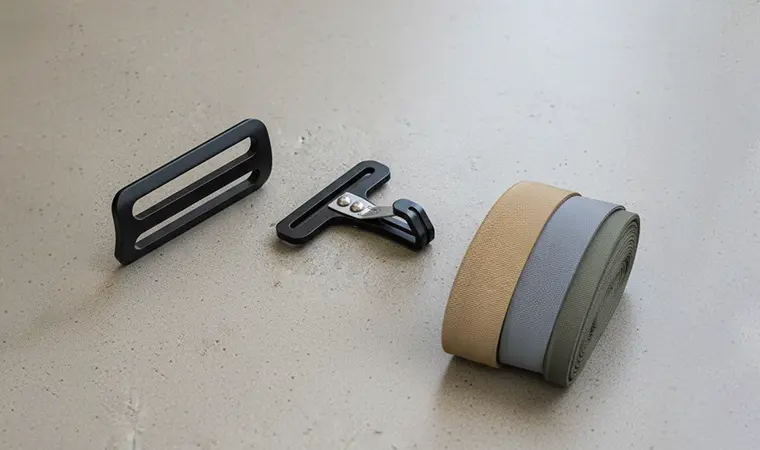In the high-stakes world of military operations, equipment failure is not an option. This is especially true for airborne and parachuting gear, where every single component is a life-saving device. For B2B buyers, tactical brands, and government contractors, sourcing parachute hardware and webbing isn't just a matter of procurement—it's a matter of ensuring absolute reliability under extreme conditions. A parachute's harness is only as strong as its weakest buckle, and its suspension lines are only as dependable as the webbing they're made from.
As a specialized manufacturer of military-grade webbing, we understand that these are not just straps and buckles; they are engineered systems. This guide provides an in-depth look at the critical components of military parachutes, explaining why Mil-Spec standards are non-negotiable and how to source parts that guarantee performance when it matters most.
The Backbone of the System: Mil-Spec Parachute Webbing
The webbing used in parachute harnesses, risers, and pack trays must withstand incredible forces, extreme weather, and severe abrasion. This is why the material of choice is invariably high-tenacity Type 6.6 Nylon, governed by stringent military specifications.
Key Specification: Decoding MIL-W-4088K
The gold standard for parachute webbing is MIL-W-4088K. This specification dictates everything from the raw material and weave construction to the breaking strength and finishing treatments. It ensures every meter of webbing provides consistent, predictable performance.
Within this spec, different "Types" are designated for specific uses:
- Heavy-Duty Types (e.g., Type 18, Type 27): These feature incredibly high tensile strengths (often exceeding 6,000 lbs) and are used for main harness construction and key structural points that bear the soldier's full weight and opening shock.
- Lighter-Weight Types: Used for pack trays, container flaps, and other areas where durability is needed without the extreme load-bearing requirements of the main harness.
Sourcing webbing that meets this standard is the first step in building a reliable parachute system. To learn more about this critical standard, read our detailed deep dive into MIL-W-4088K webbing.
Why Not Other Materials?
While polyester is excellent for many applications, nylon's inherent elasticity gives it superior shock absorption capabilities. This "give" is critical during parachute deployment, as it helps to decelerate the user more smoothly, reducing the risk of injury. Our high-performance nylon webbing is engineered specifically for these dynamic loads.
The Connection Points: Military-Grade Parachute Hardware
Webbing provides the strength, but the hardware provides the functionality and secure connections. Military parachute buckles, adjusters, and D-rings are not standard accessories; they are precision-forged components designed for fail-safe operation.
What to Look for in Mil-Spec Parachute Hardware:
- Material and Construction: True Mil-Spec hardware is typically forged from high-strength steel alloys, not stamped or bent. Forging aligns the grain structure of the metal, making it significantly stronger and more resistant to catastrophic failure.
- Corrosion Resistance: Components are often finished with a cadmium or zinc plating and a chromate treatment to resist rust and corrosion in marine or humid environments.
- Load Rating: Every piece of load-bearing hardware must have a clearly defined breaking strength that is compatible with the webbing and the overall system design.
- Design for Use: Parachute release buckles are designed for quick, one-handed operation (even with gloves on) but must be secure against accidental opening.
At TMG Webbing, we can help you source the appropriate heavy-duty hardware to complement our Mil-Spec webbing, ensuring a cohesive and reliable system.
Integrated Systems for Diverse Applications
These specialized components are used across a range of airborne systems, each with unique requirements:
- Personnel Parachute Systems (e.g., T-11, MC-6): Require the highest standards for harnesses, risers, and release mechanisms.
- Cargo Parachutes: Use extremely strong webbing and hardware to safely deliver heavy equipment and supplies.
- Drag Chutes and Extraction Systems: Rely on webbing's durability to withstand the shock and abrasion of high-speed deployments.
Our expertise extends across all these military and tactical applications, ensuring you get the right component for the mission.
A Sourcing Checklist for Military Parachute Components
When evaluating a supplier for these critical parts, your reputation and the end-user's safety are on the line. Use this checklist to ensure you're partnering with a knowledgeable and reliable manufacturer:
- Request Certification: Ask for Certificates of Conformance (CoC) to prove that the webbing meets specifications like MIL-W-4088K or other relevant standards like A-A-55301.
- Inquire About Material Traceability: Can the supplier trace the raw nylon and steel back to their source to guarantee quality?
- Verify Quality Control Processes: How do they test breaking strength, abrasion resistance, and color fastness? Do they perform lot testing to ensure consistency?
- Discuss Finishing Capabilities: Can they provide necessary treatments like water repellency or resin stiffening for specific applications?
Your Trusted Partner for Mission-Critical Components
Building equipment that performs under pressure requires components that are manufactured to the highest possible standards. By choosing a supplier with deep expertise in military specifications, you are not just buying a product; you are investing in reliability, safety, and performance.
We are committed to manufacturing and supplying the most dependable parachute webbing and accessories on the market. Our quality control system and deep understanding of military requirements make us the ideal partner for your most critical projects.
Ready to source military-grade parachute components with confidence? Contact the TMG Webbing team to discuss your technical requirements and request a quote.

